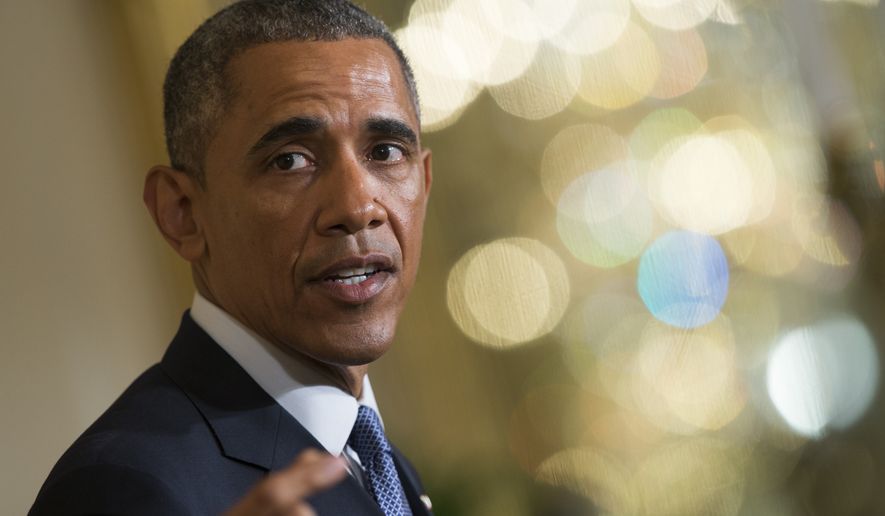President Obama has been in office exactly six years, and the wealthiest have never had it so good — and even the 2013 tax increase hasn’t been able to dampen their climb.
On Tuesday Mr. Obama set about trying to change that part of his legacy, laying out $320 billion in tax increases designed to transfer wealth almost exclusively from the richest 1 percent of Americans to the poor and middle class in the boldest and most specific tax-increase plan of his presidency.
Mr. Obama described it as a matter of fairness: increasing the capital gains tax, allowing the government to tax a higher percentage of dead Americans’ estates and imposing a new fee on big financial institutions, while using the money to pay for expanding tax credits that are used by the poor.
“Will we accept an economy where only a few of us do spectacularly well? Or will we commit ourselves to an economy that generates rising incomes and chances for everyone who makes the effort?” the president said.
The plans are already considered dead on Capitol Hill, however, where Republicans who hold majorities in both houses after November’s elections questioned why a president whose party got pasted in the November elections chose to pick a futile fight on taxes rather than offer overtures that could be the basis for common ground.
House Committee on Financial Services Chairman Jeb Hensarling, Texas Republican, called the president’s plan “trickle-down taxes,” and said the increased taxes on the wealthy will end up costing the poor anyway by raising prices for borrowing.
“Americans don’t want two sets of rules — one for the wealthy, who’ll never need a loan from a bank to buy a car, a new refrigerator or a home, and one for everyone else. But Obama’s plan to put a tax on consumer loans will do exactly that,” Mr. Hensarling said.
The fight comes as Mr. Obama’s record on taxes is hotly debated.
He signed the biggest tax increase in history, measured in raw dollars, when he approved the Affordable Care Act, which included taxes on everything from high-value health plans to an increase on the capital gains tax that primarily hits the wealthy.
He also signed one of the largest tax cuts in history when he agreed to the 2013 deal to avert the so-called “fiscal cliff,” which made many of the Bush-era tax cuts permanent for all but the richest Americans. By one budget calculation, that amounted to a $4 trillion tax cut over the course of a decade.
And throughout, his efforts to tax the wealthy have met with resistance from congressional Republicans.
“Up to this point he has to be viewed as somebody who’s tried to make the tax code a bit more progressive again, but who hasn’t tried very hard in the face of obvious opposition from the other side of the aisle,” said Robert C. Hockett, a professor at Cornell Law School who teaches monetary law and economics. “Reasonable minds can disagree as to whether he capitulated too easily or whether he recognized futility when he saw it.”
Mr. Hockett said he was happy to see Mr. Obama take a stronger approach in Tuesday’s address, facing the final two years of his tenure with little to lose, and also a chance to set the agenda for the 2016 presidential contest.
Though he’s proposed tax increases before, such as the “Buffett Rule,” which would impose a new minimum tax on millionaires, Tuesday’s address saw Mr. Obama link those tax increases on the wealthy explicitly to tax breaks for the poor and middle class.
“It’s very easy to attack the top 1 percent. They are a very easy target. Numberswise, they’re small yet very powerful,” said Thomas B. Cooke, a professor who studies tax law at Georgetown University’s McDonough School of Business.
But he said Americans “need to remind ourselves that many of the people in the top 1 percent have helped the economy become as strong as it is.”
The top 1 percent have an annual household income of slightly more than $500,000 and, as of the latest statistics, paid slightly more than one-third of the total tax burden. By contrast, the bottom 90 percent of taxpayers paid slightly less than a third. The remaining 19 percent paid the rest, according to Tax Foundation statistics.
Mr. Obama’s new proposals include raising the top capital gains tax rate to 28 percent, saying it should go back to the level it was at under President Reagan.
But Mr. Cooke said that’s misleading, because the top tax rate overall was 28 percent under Reagan, and the 1993 Clinton tax increase raised the income rate while cutting the capital gains rate.
The tax increases on the wealthy would go to pay for Mr. Obama’s new plans: two years of free community college education for all Americans, a new tax credit for couples where both parents work, raising the Earned Income Tax Credit and tripling the maximum child care tax credit to $3,000 per child.
Mr. Cooke, though, said instead of specific tax policies that play Americans against each other, the country would have been better served if Mr. Obama had proposed a broad tax simplification plan that could stimulate the economy.
He also said the repeated fights between the president and Congress over taxes have left taxpayers in the lurch.
Taxpayers went all of 2014 not knowing whether a large set of tax breaks that expired at the beginning of the year would be extended. Congress and the president finally agreed on a one-year extension in December, 11 months after the breaks expired and just before the new tax year began.
“Here we are, Jan. 2015, and I can’t even tell you what the law is for 2015,” Mr. Cooke said.
• Stephen Dinan can be reached at sdinan@washingtontimes.com.




Please read our comment policy before commenting.